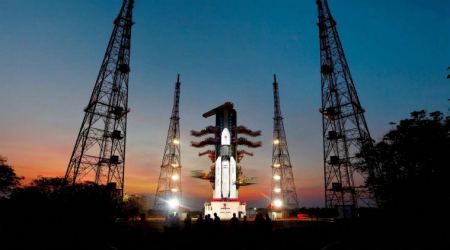 The GSLV MK III-D1 rocket carrying the GSAT-19 satellite will lift off from the Satish Dhawan Space Centre at Sriharikota in Andhra Pradesh at 5.28 pm.
The GSLV MK III-D1 rocket carrying the GSAT-19 satellite will lift off from the Satish Dhawan Space Centre at Sriharikota in Andhra Pradesh at 5.28 pm.
The Indian Space Organisation (ISRO) on Monday launched one of its heaviest communication satellites, the GSAT-19. The launch vehicle, GSLV MK III-D1, became the heaviest rocket to be used till date.
ISRO GSAT-19 satellite launch live updates:
5.55 pm: That is all from us today. Thank you all for joining us for the launch. Congratulate our ISRO scientists in the comments below.
5.49 pm: Here is a video for those who missed the launch.
ISRO launches its most powerful rocket GSLV Mark III carrying GSAT-19 communication satellite from Sriharikota, AP #GSLVMK3 pic.twitter.com/3Tnme9Qlz5
— ANI (@ANI_news) June 5, 2017
5.45 pm: Prime Minister Narendra Modi congratulates ISRO on its success. “Congratulations to the dedicated scientists of ISRO for the successful launch of GSLV – MKIII D1/GSAT-19 mission,” PM Modi tweeted.
President Pranab Mukherjee also congratulated the ISRO scientists. “Heartiest congratulations to ISRO on the historic launch of GSLV-Mk III. GSLV-Mk III is the heaviest rocket ever made by India and is capable of carrying the heaviest satellites made till date. The nation is proud of this significant achievement,” Pranab Mukherjee tweeted.
5.42 pm: Today is a historic day, we have successfully been able to put the satellite into the orbit. In its maiden flight, it has successfully managed to put the GSAT-19 in orbit: ISRO chairman Kiran kumar
5.40 pm: The payload has successfully separated from the GSLV MK III-D1. ISRO chairman Kiran Kumar is making a statement.
5.35 pm: We are now 11 minutes into the launch. As things stand, all parameters appear to be normal so far. The rocket is heading in the right trajectory.
5.32 pm: About 5.45 we will know whether this launch has been successful or not. The mission has now entered its final stage, the cryogenic stage. ISRO is hoping to use this rocket as launch vehicle for manned missions in the future.
5.30 pm: The solid motor strap-ons have been disengaged. The vehicle now is in the second state, where the liquid propellant core will kick in.
5.28 pm: ISRO breaks the first launch jinx, we have a lift off. The rocket appears to be going in the right trajectory.
5.27 pm: We don’t want to jinx this, but when ISRO first launched the PSLV it ended in failure in 1993. The GSLV launch in 2001 also met with the same fate.
5.25 pm: We are just minutes away from the satellite launch. The GSLV-Mk III is capable of launching satellites weighing up to 4,000 kg to the Geosynchronous Transfer orbit (GTO). It is a three-stage vehicle with two solid motor strap-ons, a liquid propellant core stage and a cryogenic stage.
5.20 pm: India has come a long way from the 60s where we saw ISRO use different launch vehicles — SLV, ASLV, PSLV and GSLV — down the years. The latest GSLV MK III-D1 stands as tall as 12-storey building i.e 43.39 m long.
5.15pm: We are now seeing visuals from inside the mission control room where the directors are checking various parameters of the GSLV. Vehicle director confirms vehicle preparedness of the mission.
5.10 pm: The GSLV Mk III-D1’s indigenous cryogenic upper stage engine allows its to carry heavy satellites into the Geosynchronous Transfer Orbit. If successful today, India will have a single communication satellite that is equivalent to having six to seven satellites of older variety.
5.05 pm: Earlier the GSLV MK III was used to test ISRO’s orbital vehicle. The space organisation succeeded in the Crew module Atmospheric Reentry experiment. The test vehicle splashed down in the Bay of Bengal as planned.
5.00 pm: Before ISRO developed the heavy-lift GSLV MK III-D1, they relied on foreign players to launch some of its heavier satellites. The GSAT-18, which weighs 3,404 kg, was launched from Ariane, French Guiana.
4.55 pm: Hours before the launch, ISRO Chairman A S Kiran Kumar said the mission was important as “it was the heaviest-ever rocket and satellite to be launched from the country”.
The rocket carrying the GSAT-19 satellite lifted off from the Satish Dhawan Space Centre at Sriharikota in Andhra Pradesh at 5.28 pm. The GSLV MK III-D1 is capable of carrying payloads of up to 4,000 kg into the Geosynchronous Transfer Orbit (GTO) and 10,000 kg into the Low Earth Orbit.

